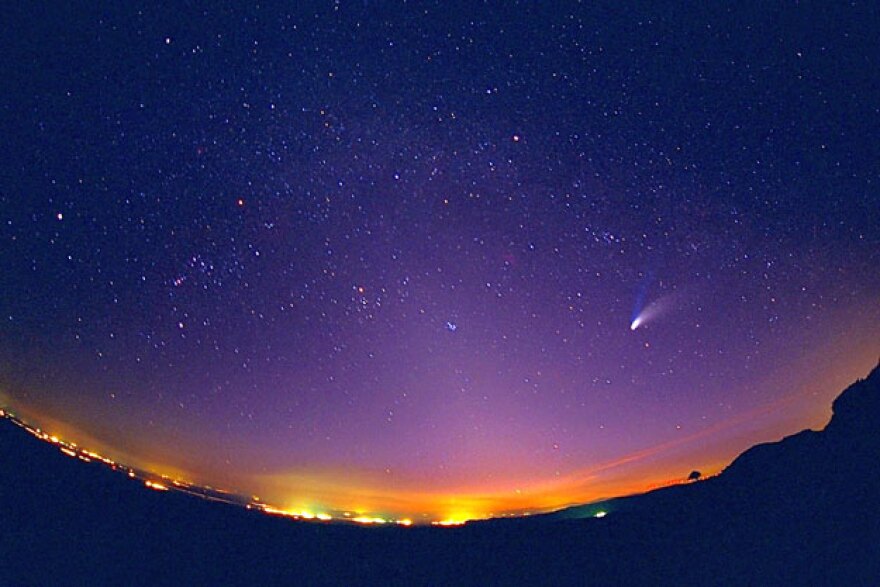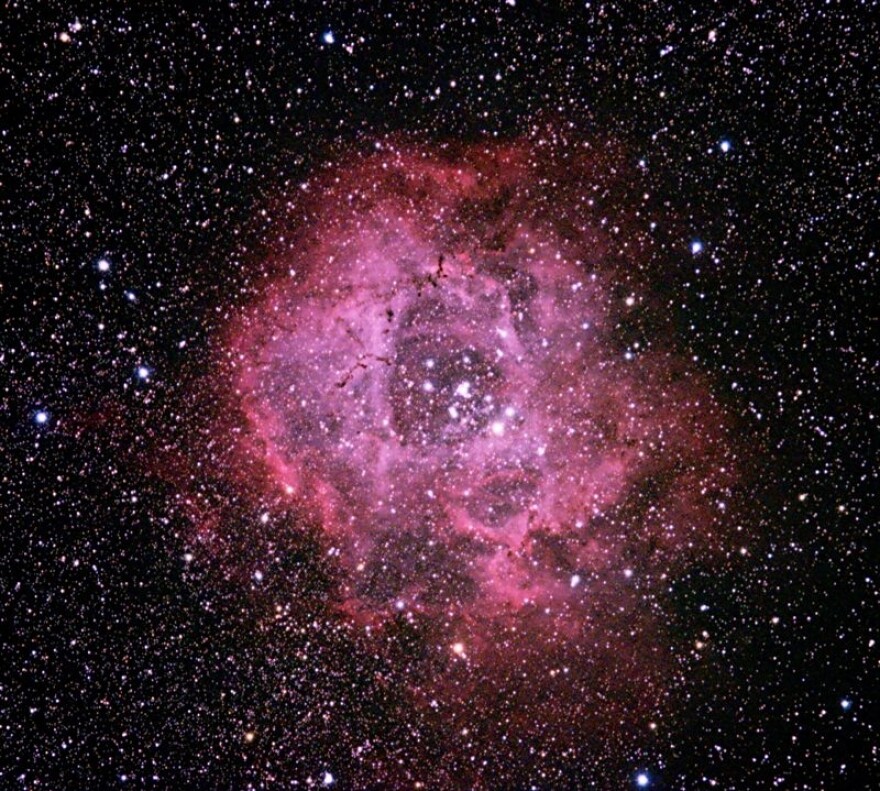For February 2021, the Moon is last quarter on Feb. 4, and new on Feb. 11. The waxing crescent passes just south of Mars on Feb. 18, and is first quarter the following evening. The full moon is the Hunger or Wolf Moon, and is on Feb. 27.
Except for Mars, all the planets lie too close to the sun for easy observation this month. Even Mars is disappointing telescopically, for the earth has left it far behind since the close opposition last fall, and it is only a tiny red disk high in the evening sky in Aries at nightfall. But next month Jupiter and Saturn return to the dawn, and by summer Venus will be back in the evening skies.
While the naked eye, dark adapted by several minutes away from any bright lights, is a wonderful instrument to stare up into deep space, far beyond our own Milky Way, binoculars are better for spotting specific deep sky objects. Visit Skymaps for a list of best objects for the naked eyes, binoculars, and scopes on the back of the map.
The constellation Cassiopeia makes a striking west in the northwest. She contains many nice star clusters for binocular users in her outer arm of our Milky Way, extending to the northeast now.
Cassiopeia’s daughter, Andromeda, starts with the northeast corner star of Pegasus’’ Square, and goes northeast with two more bright stars in a row. It is from the middle star, beta Andromeda, that we proceed about a quarter the way to the top star in the west of Cassiopeia, and look for a faint blur with the naked eye. M-31, the Andromeda Galaxy, is the most distant object visible with the naked eye, about 2.5 million light years away.
Overhead is Andromeda’s hero, Perseus. Between him and Cassiopeia is the fine Double Cluster, faintly visible with the naked eye and two fine binocular objects in the same field. Perseus contains the famed eclipsing binary star Algol, where the Arabs imagined the eye of the gorgon Medusa would lie. It fades to a third its normal brightness for six out of every 70 hours, as a larger but cooler orange giant covers about 80% of the smaller but hotter and thus brighter companion as seen from Earth.
At Perseus’ feet for the famed Pleiades cluster; they lie about 400 light years distant, and over 250 stars are members of this fine group. East of the seven sisters is the V of stars marking the face of Taurus the Bull, with bright orange Aldebaran as his eye; use it (mag. +0.9) as a comparison star to measure the fading of Betelguese. The V of stars is the Hyades cluster, older than the blue Pleiades, but about half their distance.
Yellow Capella, a giant star the same temperature and color as our much smaller Sun, dominates the overhead sky. It is part of the pentagon on stars making up Auriga, the Charioteer (think Ben Hur). Several nice binocular Messier open clusters are found in the winter milky way here. East of Auriga, the twins, Castor and Pollux highlight the Gemini; they were the first two recruits for the Argonauts of the University of West Florida.
South of Gemini, Orion is the most familiar winter constellation, dominating the eastern sky at dusk. The reddish supergiant Betelguese marks his eastern shoulder, while blue-white supergiant Rigel stands opposite on his west knee. Betelguese is also known as alpha Orionis, for it has been the brightest star in Orion most of the time. But last year it faded due to an expulsion of condensing carbon dust (soot) blown off in our direction, and was only one-third its greatest brightness. But now this cloud has dissipated and it is back close to normal.
Just south of the belt, hanging like a sword downward, is M-42, the Great Nebula of Orion, an outstanding binocular and telescopic stellar nursery. The bright diamond of four stars that light it up are the trapezium cluster, one of the finest sights in a telescope. Just east of Betelguese is the fine binocular cluster NGC 2244. But the much fainter Rosette Nebula that it lies in the center of requires bigger scopes or astrophotography.
In the east rise the hunter’s two faithful companions, Canis major and minor. Procyon is the bright star in the little dog, and rises before Sirius, the brightest star in the sky. Midway between them is the fine Rosette Nebula, a star nursery including the nice open cluster NGC 2244, easily found in binoculars. Appropriate for Valentine’s Day, here is our cosmic rose, with much gas and the same kind of dark dust Betelguese blew out, but now not marking a star’s death, but birth of new solar systems like our own, with the dust becoming us, residents of terrestrial rocky worlds like Earth.

Sirius dominates the southeast sky by 7 p.m., and as it rises, the turbulent winter air causes it to sparkle with shafts of spectral fire. Beautiful as the twinkling appears to the naked eye, for astronomers this means the image is blurry; only in space can we truly see “clearly now." At eight light years distance, Sirius is the closest star we can easily see with the naked eye from West Florida.
When Sirius is highest, along our southern horizon look for the second brightest star, Canopus, getting just above the horizon and sparkling like an exquisite diamond as the turbulent winter air twists and turns this shaft of starlight, after a trip of about 200 years!
To the northeast, a reminder that spring is coming; look for the bowl of the Big Dipper to rise, with the top two stars, the pointers, giving you a line to find Polaris, the Pole Star. But if you take the pointers south, you are guided instead to the head of Leo the Lion rising in the east, looking much like the profile of the famed Sphinx. The bright star at the Lion’s heart is Regulus, the “regal star.” Fitting for our cosmic king of beasts, whose rising at the end of this month means March indeed will be coming in “like a lion.”
The EAAA public gazes at the beaches are suspended due to COVID, so stay safe and get vaccinated so we can all get back to enjoying the skies together again. For more information on the Escambia Amateur Astronomers and our local star gazes for the public, visit eaaa.net or join us on Facebook at Escambia Amateur Astronomers.

